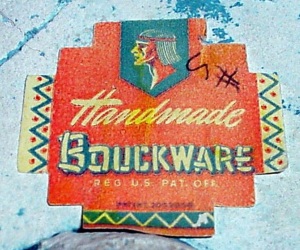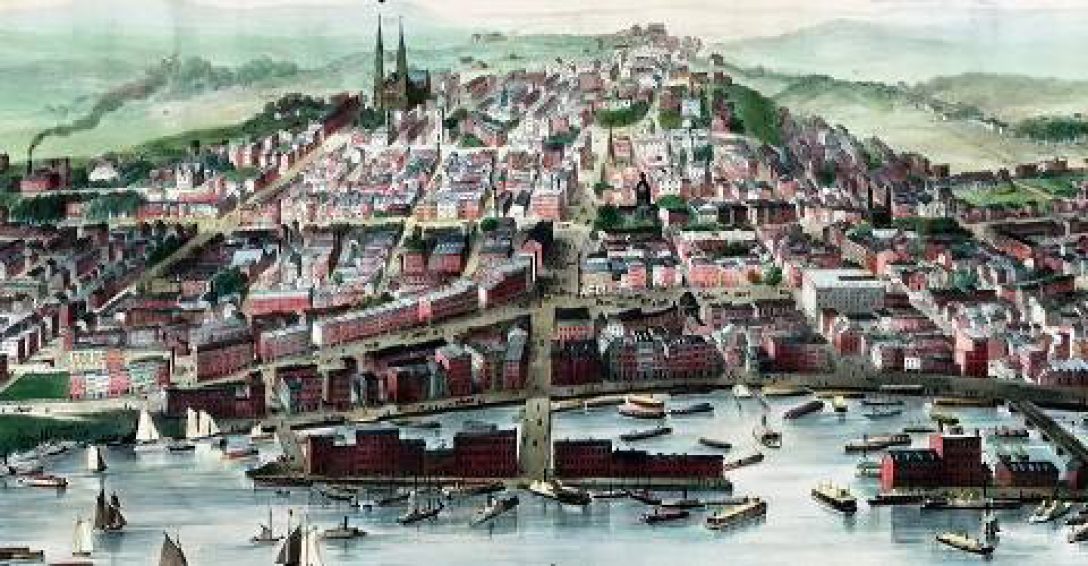
In the 1930s, an unconventional man named Bouck White built a “castle” in the Helderberg Mountains overlooking the village of New Salem, New York. Hoping to create his own Utopia, he spent a decade there, selling pottery and dispensing shards of philosophy to visitors.
Charles Browning “Bouck” White was born in Middleburgh, Schoharie County in 1874. His father ran a dry goods store and young White grew up in comfort in the family’s Grove Street home. He attended local schools and continued his education at Syracuse University where his conduct was described as “honorable.” In the college yearbook, he maturely observed, “The line between folly and wisdom is often as imaginary one, and men are often seen traveling along with one foot on either side of it.”
White transferred to Harvard and graduated in 1896. He went to work as a reporter for the Springfield Republican, but a year later he began studies at the Boston Theological Institute. He was ordained a Congregational minister in 1904 and spent the next several years in Clayton, a town on the St. Lawrence River. He organized a Boys Club, opened a small library, and converted a stable into a gymnasium for the town’s youth. The townspeople were initially dubious of White’s innovations, but were won over and provided funding.
 Around 1908 White moved to Brooklyn to work at a settlement house run by Trinity Church. There he saw the hardships of the poor and working classes. White joined the Socialist Party, hoping that a blend of religion and socialism would cure the world’s spiritual and social woes. The Church vestrymen grew wary and asked for his resignation. He submitted it, found the Church of Social Revolution and wrote the first of his books, “The Call of the Carpenter” in 1912, which portrayed as a workingman, agitator, and social revolutionist. Known as New York’s “most eccentric radical,” he wore a coarse smock in protest of World War I. He was later expelled from the Socialist party for opposing violence.
Around 1908 White moved to Brooklyn to work at a settlement house run by Trinity Church. There he saw the hardships of the poor and working classes. White joined the Socialist Party, hoping that a blend of religion and socialism would cure the world’s spiritual and social woes. The Church vestrymen grew wary and asked for his resignation. He submitted it, found the Church of Social Revolution and wrote the first of his books, “The Call of the Carpenter” in 1912, which portrayed as a workingman, agitator, and social revolutionist. Known as New York’s “most eccentric radical,” he wore a coarse smock in protest of World War I. He was later expelled from the Socialist party for opposing violence.
 In 1914 White was arrested at the Fifth Avenue Baptist Church after disrupting a service by challenging the Reverend Cornelieus Woelfkin to debate the civic value of John D. Rockefeller, Jr., whom White held answerable for the massacre of striking miners in Ludlow, Colorado. White was sentenced to six months in jail. During that time he wrote “Letters from Prison” which defined his credo of Christian socialism.
In 1914 White was arrested at the Fifth Avenue Baptist Church after disrupting a service by challenging the Reverend Cornelieus Woelfkin to debate the civic value of John D. Rockefeller, Jr., whom White held answerable for the massacre of striking miners in Ludlow, Colorado. White was sentenced to six months in jail. During that time he wrote “Letters from Prison” which defined his credo of Christian socialism.
White led a “service” to protest World War I in 1916. He set fire to flags representing the world’s leading nations and covered the ashes with a crimson flag. Claiming that the fire had only united the banners into one of “internationalism,” White was jailed for desecrating the flag. At his trial the prosecutor described White as an “egotistical humbug….If an American in his indignation had shot White dead on the night of the flag burning, I doubt if you could find a juryman who would vote to convict him.” White got a $100 fine and thirty days in the “workhouse” for the flag burning.
After his release, he moved to France to study ceramics and developed a chemical process that enabled him to harden pottery without a kiln. At a Mardi Gras bazaar in Paris on February 1, 1921, White met Emilee Simone. He asked permission to call on her and, three days later, proposed marriage. Emilee’s parents were charmed by White who spoke French fluently and appeared prosperous. The couple married that April; he was 47 and she was 21.
The Whites returned immediately to America and moved to a farmhouse on a mountain outside Marlboro in Ulster County. But Mrs. White fled from her husband’s “summer estate” after three days and went to the Marlboro Mountain House. She told of abuse. She said White wanted her to be a “radical prophetess”. Some nights later, a dozen men from Marlboro abducted White. He was tarred, feathered, whipped, dunked in Orange Lake, and threatened with hanging. (After his captors released him, people noticed blisters on White’s neck. It was rumored that acid was mixed with the tar. White said they were caused by sunburn, but tried to hide the blisters with flour.)
Emilee filed for an annulment. She had little money, but did not wish to return to France until she was free of White. She described White’s farmhouse as slovenly, White himself autocratic and eccentric. He was not interested in children, but told her that they would write books together and the books would be their children. . He denied considering himself the “Second Messiah,” but admitted that “intellectual persons” should have books instead of children. An annulment was granted that summer on the grounds that White had hidden his arrest record from the Simones.
 White returned to France, but by 1932, he was back in New York and running a pottery studio in an Albany carriage house. In 1934, White bought six acres in the Helderberg Mountains. He was attracted to the lonely cliff by a belief that it was where Hiawatha supposedly experienced visions that lead to the founding of the Iroquois Confederacy. White had long claimed Mohawk ancestry, saying, “I don’t know how much of the blood of Hiawatha is in my veins, but my heart is Indian.”
White returned to France, but by 1932, he was back in New York and running a pottery studio in an Albany carriage house. In 1934, White bought six acres in the Helderberg Mountains. He was attracted to the lonely cliff by a belief that it was where Hiawatha supposedly experienced visions that lead to the founding of the Iroquois Confederacy. White had long claimed Mohawk ancestry, saying, “I don’t know how much of the blood of Hiawatha is in my veins, but my heart is Indian.”
 White constructed a “castle” using the plentiful limestone. He worked as independently of technology (which he distrusted as much as wealth) a possible. He described his building style: “The stones are not hacked or broken to form a window opening of some perceived pattern; they are allowed….to build a window of any form whatsover…A new resource for the architect is here emerging, provided their clients be animated by a spirit of natural beauty.”
White constructed a “castle” using the plentiful limestone. He worked as independently of technology (which he distrusted as much as wealth) a possible. He described his building style: “The stones are not hacked or broken to form a window opening of some perceived pattern; they are allowed….to build a window of any form whatsover…A new resource for the architect is here emerging, provided their clients be animated by a spirit of natural beauty.”
White built an impressive tower at the cliff’s edge. The view from the top rivaled the vista offered at nearby John Boyd Thatcher State Park. White kept carrier pigeons at the tower and, during World War II, his birds led people to speculate that White was a spy using pigeons to send messages to the enemy.
 White lived simply at his mountain retreat and his sole income came from selling his pottery “Bouckware”, primarily through gift shops across the country. (In 1937 he organized a small corporation for this purpose with 2 men from Albany.) He lived on pancakes, soups, and cornmeal. He wore old baggy trousers and tattered sneakers. Old or new acquaintances were treated hospitably. White realized that he was not capable of changing the world. He dismissed his radical activities as part of a “collective insanity” that afflicted the country during World War I and admitted his own mortality. He desired only to end his days peacefully on his mountain, but a stroke forced him to move to the Home for Aged Men in Menands.
White lived simply at his mountain retreat and his sole income came from selling his pottery “Bouckware”, primarily through gift shops across the country. (In 1937 he organized a small corporation for this purpose with 2 men from Albany.) He lived on pancakes, soups, and cornmeal. He wore old baggy trousers and tattered sneakers. Old or new acquaintances were treated hospitably. White realized that he was not capable of changing the world. He dismissed his radical activities as part of a “collective insanity” that afflicted the country during World War I and admitted his own mortality. He desired only to end his days peacefully on his mountain, but a stroke forced him to move to the Home for Aged Men in Menands.
In 1944 the property was purchased by Gabriel Cordevez, a Bouck White disciple, He intended to establish an artist colony, but a fire damaged much of the main building later that year. In 1946, after the end of War II, Mr Cordevez established the Shrine of the Ave Marias, dedicated to all Gold Star mothers of any nation, in a small chapel that had been built by Bouck White. In the early 1950s the property was purchased by a family named Regan; 4 generations of the family owned the property for at least 30 years..
But what of Bouck White? He died in January 7, 1951, and his ashes were buried in a fissure near his Helderberg castle.

From Paula Lemire’s blog Garden Alley












sounds like a strange but true story! you can not make this stuff up. I had heard of a castle but thought it was an urban myth. what an interesting character is the fellow who built it! I started reading to find out about the castle and found the human story just as, if not more, interesting.-hugs
LikeLike
A lot was left out of this true story! Like the 2 Sweedish men that helped him build that Castle! Karl Bergstrom was my grandfather and Sygurd was his brother and they helped Bouck build the castle! My mother spent the first 2 years of her life in that castle. Karl & Sygurd helped Bouck make all that pottery! They were still making pottery in 1950 in the pottery shop! A fire did destroy part of the castle which was why my mother didn’t live there any longer.
LikeLike
[…] Bouck White – Helderberg Hermit and his Castle – Friends of Albany History […]
LikeLike
[…] happened to have opened it to tourists. More about Mr. White and photos of his pottery can be found here, and more recent photos of the castle, […]
LikeLike